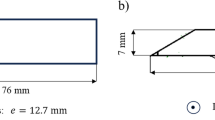Abstract
As nickel-based alloy Inconel 718 has poor thermal conductivity and serious work hardening, it is classified as a difficult-to-cut material. The tool wear is very serious. In this paper, PVD-coated carbide tools were employed to cut Inconel 718. Firstly, tool wear morphology and tool wear mechanism were studied. The results show that tool wear characteristic changed with cutting speeds. There was an optimum cutting speed at which oxides serving as boundary lubrication layer formed. These oxides can reduce the friction coefficient of the tool-chip contact surface and inhibit tool wear. Secondly, according to the wear mechanism analysis, tool flank wear model was established in the light of wear delamination theory. The optimum cutting temperature was proposed, and it was calculated using the established model. At the optimum cutting temperature, tool wear can reach the minimum value. At last, verification experiments for the optimum cutting temperature were carried out. For a pair of tool-workpiece, the minimal tool wear can be obtained by optimizing cutting conditions so as to make the cutting temperature reach the optimum value. This provides a good method for tool wear control. It also provides a theoretical basis and effective means for a reasonable choice of cutting parameters.
Similar content being viewed by others
References
Olovsjȍ S, Nyborg L (2012) Influence of microstructure on wear behavior of uncoated WC tools in turning of Alloy718 and Waspaloy. Wear 282–283:12–21. doi:10.1016/j.wear.2012.01.004
Altin A, Nalbant M, Taskesen A (2007) The effects of cutting speed on tool wear and tool life when machining Inconel 718 with ceramic tools. Mater Des 28:2518–2522. doi:10.1016/j.matdes.2006.09.004
Costes JP, Guillet Y, Poulachon G, Dessoly M (2007) Tool-life and wear mechanisms of CBN tools in machining of Inconel 718. Int J Mach Tools Manuf 47:1081–1087. doi:10.1016/j.ijmachtools.2006.09.031
Cantero JL, Díaz-Álvarez J, Miguélez MH, Marín NC (2013) Analysis of tool wear patterns in finishing turning of Inconel 718. Wear 297:885–894. doi:10.1016/j.wear. 2012.11.004
Nalbant M, Altin A, Gökkaya H (2007) The effect of coating material and geometry of cutting tool and cutting speed on machinability properties of Inconel 718 super alloys. Mater Des 28:1719–1724. doi:10.1016/j.matdes.2006.03.003
Devillez A, Schneider F, Dominiak S, Dudzinski D, Larrouquere D (2007) Cutting forces and wear in dry machining of Inconel 718 with coated carbide tools. Wear 262:931–942. doi:10.1016/j.wear.2006.10.009
Fan YH, Hao ZP, Lin JQ, Yu ZX (2014) Material response at tool-chip interface and its effects on tool wear in turning Inconel 718. Mater Manuf Process 29:1446–1452. doi:10.1080/10426914.2014.921701
Fan YH, Hao ZP, Zheng ML, Sun FL, Yang SC (2013) Study of surface quality in machining nickel-based alloy Inconel 718. Int J Adv Manuf Technol 69:2659–2667. doi:10.1007/s00170-013-5225-1
Bhatt A, Attia H, Vargas R, Thomson V (2010) Wear mechanisms of WC coated and uncoated tools in finish turning of Inconel 718. Tribol Int 43:1113–1121. doi:10.1016/j.triboint.2009.12.053
Hao ZP, Gao D, Fan Y, Han RD (2011) New observations on tool wear mechanism in dry machining Inconel 718. Int J Mach Tools Manuf 51:973–979. doi:10.1016/j.ijmachtools.2011.08.018
Díaz-Álvarez J, Cantero JL, Miguélez H, Soldani X (2014) Numerical analysis of thermomechanical phenomena influencing tool wear in finishing turning of Inconel 718. Int J Mech Sci 82:161–169. doi:10.1016/j.ijmecsci.2014.03.010
Virginia GN, Iban A, Oscar G, Josu L (2013) Mechanisms involved in the improvement of Inconel 718 machinability by laser assisted machining (LAM). Int J Mach Tools Manuf 74:9–28. doi:10.1016/j.ijmachtools.2013.06.009
Hsu CY, Lin YY, Lee WS, Lo SP (2008) Machining characteristics of Inconel 718 using ultrasonic and high temperature-aided cutting. J Mater Process Technol 198:359–365. doi:10.1016/j.jmatprotec.2007.07.015
Fan YH, Hao ZP, Lin JQ, Yu ZX (2014) New observations on tool wear mechanism in machining Inconel 718 under water vapor + air cooling lubrication cutting conditions. J Clean Prod. doi:10.1016/j. jclepro. 2014.11.049
Umbrello D (2013) Investigation of surface integrity in dry machining of Inconel 718. Int J Adv Manuf Technol 69:2183–2190. doi:10.1007/s00170-013-5198-0
Acchar W, Gomes UU, Kaysser WA, Goring J (1999) Strength degradation of a tungsten carbide-cobalt composite at elevated temperatures. Mater Charact 43:27–32. doi:10.1016/S1044-5803(98)00056-4
Author information
Authors and Affiliations
Corresponding author
Rights and permissions
About this article
Cite this article
Hao, Z., Fan, Y., Lin, J. et al. Wear characteristics and wear control method of PVD-coated carbide tool in turning Inconel 718. Int J Adv Manuf Technol 78, 1329–1336 (2015). https://doi.org/10.1007/s00170-014-6752-0
Received:
Accepted:
Published:
Issue Date:
DOI: https://doi.org/10.1007/s00170-014-6752-0




